NOTES
Thursday, June 28, 2007
07:00
Blue sky in the east with clouds moving in from the west
Metal/blue|red/green arrives first this morning with what appear to be downy feathers clinging to its back. Unbanded follows; pecks at the seed wedged tightly between the boards of the deck, all that remain after the raccoon party last night. The size and shape of the bill are designed precisely for the task. Metal/red|green/orange swoops down for a quick survey, passes on the hulls, and flies south. I hear his call in the distance, recognize the hoarse end note and bring out the peanuts. He feeds on seeds, not peanuts yet.
Metal/black|orange/white perches on the deck, takes some seed, stands tall, looks side to side, alert to the possibility of a chase. Resident male chases him though not far--to the roof, to the feeder, then back to a pile of seed on the deck, where he feeds successfully. His persistence has paid off. Unbanded grabs one peanut, perches on a tree branch and begins the nut cracking ritual, toes clinging, tap, tap, tap, he nimbly places one half a nut next to his foot, eats the other, and is chased by resident male, who returns to devour the half nut left on the branch.
Resident female perches on the edge of the feeder, positions her cache, as always, criss-cross, and flies south--no lingering for her. Mr/go, her partner, hops clear into the trap, making me think again that Pia will be successful trapping him this year. I've narrowed the opening by sliding the trap door to the right, and placed nuts far against the back wall.
A large rat scurries up the back side of the feeder, tries to enter through the hexagonal openings of the chicken wire and is frightened when I open the door, he disappears quickly. I've missed my photo op.
Unbanded is back, eats one peanut in the tree, returns to the pile and begins shopping. First, he picks up a nut, rotates it in his mouth, places it in his gullet. He thrusts it forward, rotates again, spits it out, picks up another nut, and repeats the same procedure. The new nut bulges, clearly visible from the forced opening of his bill. He shops again, now for his second nut, picks up/puts down, picks up/puts down, over eight times, until he finally chooses and flies south.
Mb/ow perches on the feeder's edge, eating seeds, although there are still lots of peanuts from which to choose. He seems a bit skittish in the trap, is easily startled by sound, though persists, indicating a certain kind of boldness in a territory not claimed as his own.
A new unbanded bird, legs swollen from mites, perches, quickly grabs a nut and flies off. I can hear the tap tapping in the distance. Mw/bw takes his first turn for the day at the feeder. Mb/rg feeds off and on, the down no longer attached to its back. Mb/obl returns, perches at the feeder, fills up on seed, and flies south--always in the same direction. Her mate calls raucously in the background.
Purple/black-metal/red, unbanded, mb/ow all swoop to the bench at the same time. Pb/mr is first, takes only one nut quickly and flies. Unbanded is second, while mb/ow lingers. He flies off in a more westward direction, after moving clear into the trap. Pb/mr returns, once again, only taking one nut. Next trip, she perches on the feeder, but still only takes one nut, appearing skittish. Unbanded with leg mites perches, lowers his head into the trap, lifts his posterior, and exposes a new set of tail feathers patterned neatly on top of the old. I think this bird is one of last year's juveniles that was never banded.
Total birds: 7-8
Blue sky in the east with clouds moving in from the west
Metal/blue|red/green arrives first this morning with what appear to be downy feathers clinging to its back. Unbanded follows; pecks at the seed wedged tightly between the boards of the deck, all that remain after the raccoon party last night. The size and shape of the bill are designed precisely for the task. Metal/red|green/orange swoops down for a quick survey, passes on the hulls, and flies south. I hear his call in the distance, recognize the hoarse end note and bring out the peanuts. He feeds on seeds, not peanuts yet.
Metal/black|orange/white perches on the deck, takes some seed, stands tall, looks side to side, alert to the possibility of a chase. Resident male chases him though not far--to the roof, to the feeder, then back to a pile of seed on the deck, where he feeds successfully. His persistence has paid off. Unbanded grabs one peanut, perches on a tree branch and begins the nut cracking ritual, toes clinging, tap, tap, tap, he nimbly places one half a nut next to his foot, eats the other, and is chased by resident male, who returns to devour the half nut left on the branch.
Resident female perches on the edge of the feeder, positions her cache, as always, criss-cross, and flies south--no lingering for her. Mr/go, her partner, hops clear into the trap, making me think again that Pia will be successful trapping him this year. I've narrowed the opening by sliding the trap door to the right, and placed nuts far against the back wall.
A large rat scurries up the back side of the feeder, tries to enter through the hexagonal openings of the chicken wire and is frightened when I open the door, he disappears quickly. I've missed my photo op.
Unbanded is back, eats one peanut in the tree, returns to the pile and begins shopping. First, he picks up a nut, rotates it in his mouth, places it in his gullet. He thrusts it forward, rotates again, spits it out, picks up another nut, and repeats the same procedure. The new nut bulges, clearly visible from the forced opening of his bill. He shops again, now for his second nut, picks up/puts down, picks up/puts down, over eight times, until he finally chooses and flies south.
Mb/ow perches on the feeder's edge, eating seeds, although there are still lots of peanuts from which to choose. He seems a bit skittish in the trap, is easily startled by sound, though persists, indicating a certain kind of boldness in a territory not claimed as his own.
A new unbanded bird, legs swollen from mites, perches, quickly grabs a nut and flies off. I can hear the tap tapping in the distance. Mw/bw takes his first turn for the day at the feeder. Mb/rg feeds off and on, the down no longer attached to its back. Mb/obl returns, perches at the feeder, fills up on seed, and flies south--always in the same direction. Her mate calls raucously in the background.
Purple/black-metal/red, unbanded, mb/ow all swoop to the bench at the same time. Pb/mr is first, takes only one nut quickly and flies. Unbanded is second, while mb/ow lingers. He flies off in a more westward direction, after moving clear into the trap. Pb/mr returns, once again, only taking one nut. Next trip, she perches on the feeder, but still only takes one nut, appearing skittish. Unbanded with leg mites perches, lowers his head into the trap, lifts his posterior, and exposes a new set of tail feathers patterned neatly on top of the old. I think this bird is one of last year's juveniles that was never banded.
Total birds: 7-8
Subscribe to:
Post Comments (Atom)
Pia Sets the Trap
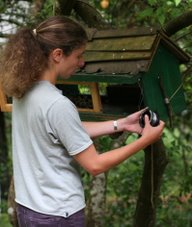
07/24/07
Peaking...
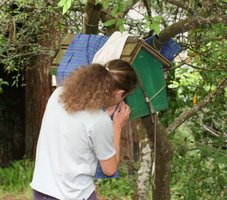
07/24/07
Oops, wrong bird!
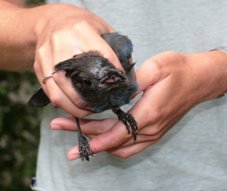
Demonstrating the "hold"
Try Again
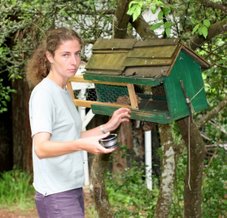
Bird in the Bag
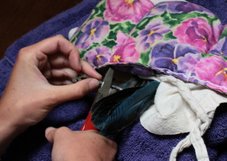
Applying a metal band
Measuring

and more measuring. . . .
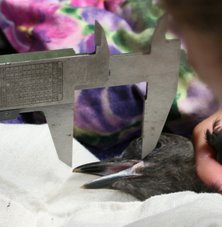
Blood Sampling
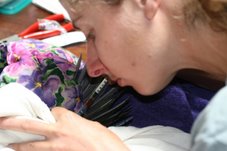
Jeff J's Work

Pia's test tube holder
Weighing
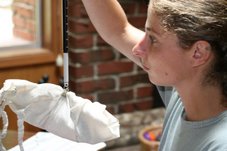
And then....release
When the sun goes down...
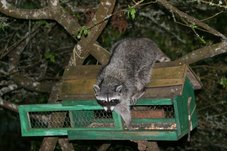
Steller's Jay Taxonomy/Description
Common Name: Steller's Jay
Class: Aves
Order: Passeriformes
Family: Corvidae
Genus: Cyanocitta
Species: Cyanocitta stelleri
Steller’s jay belongs to the family, Corvidae, in the Avian Order Passeriformes. Passeriformes is the order of perching birds. Corvidae is the jay, magpie and crow family. The Steller's jay's scientific name is Cyanocitta stelleri. The generic name, cyanocitta, means "blue jay". Its specific name, stelleri, named for George W. Steller (1709-1746). Steller was a German zoologist who explored the coastal areas of the northern Pacific Ocean in 1740.
Band Colors
black | white | purple | red | orangeBands are read in the following order:
light blue and light blue | green
Note: Light blue is difficult to read. It darkens with age, resembling a green band. (b/w/p/r/o/lb/g)
right bottom band
right top band
left bottom band
left top band
Data Collecting
This information was copied from the website of Dr. Jeff Black, Humboldt State University Wildlife Department.
The data to include for each record:
- Bird’s color code
- Size of social group seen at the same time
- Associates’ color codes (or if unbanded = UNB; or not determined = NOTD)
- Number of times associates came within 3 meters of each other
- Approximate time spent within 3 meter distance (e.g. 2 seconds, 15 sec, etc.)
- Total time you watched the birds (e.g. 5 minutes, 10 min, etc.)
- Time of day; start of observation (e.g. 1935)
- Date (e.g. 9.30.99)
- Location of observation (e.g. Rewood Bowl SW corner west bleachers. And state whether the bird was seen at a birdfeeder or in trees, etc)
- Comments (e.g. deformed leg, feather tuft on back, etc.)
Arcata Steller's Jay Sightings
Mr. Go
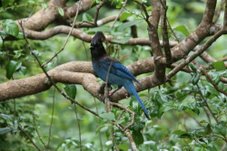
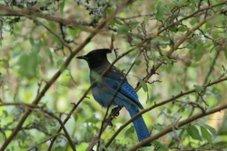
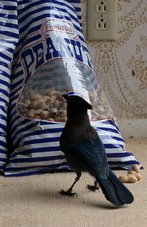
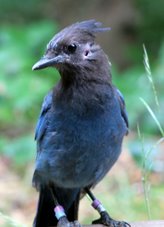
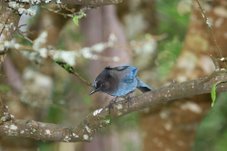
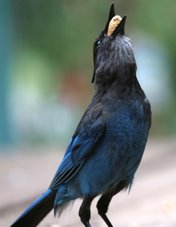
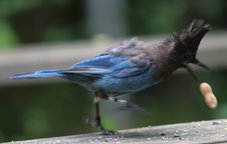
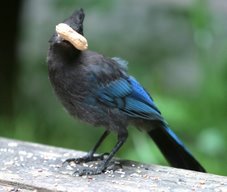
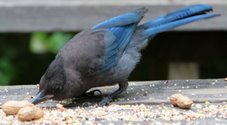
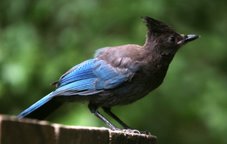
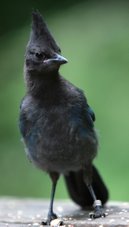

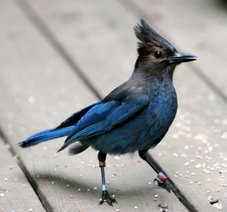
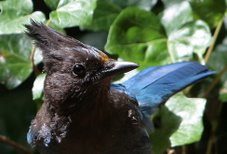
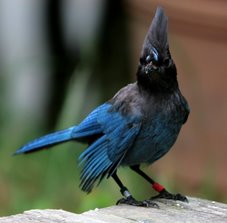
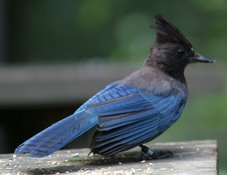
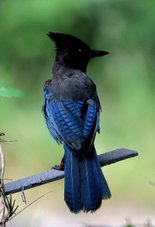
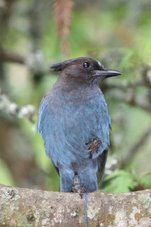
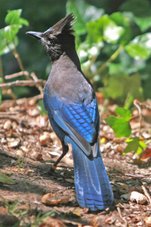
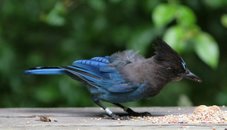
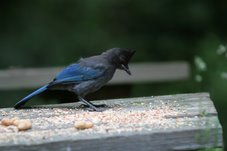
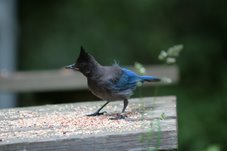
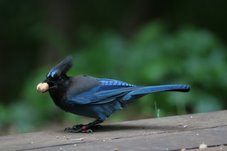
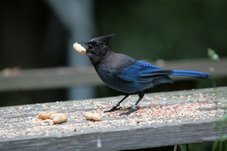
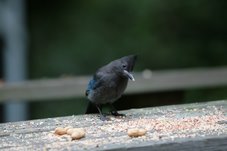
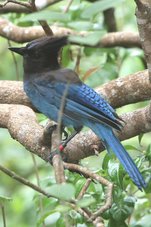
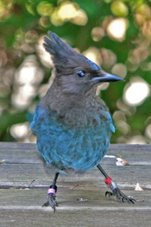
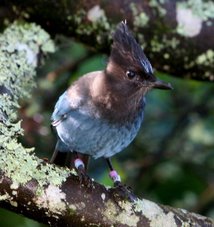
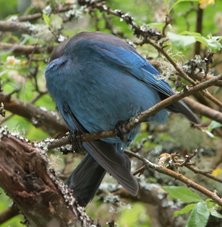
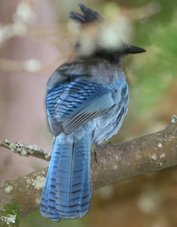
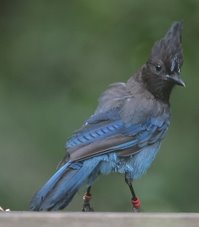
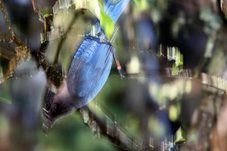
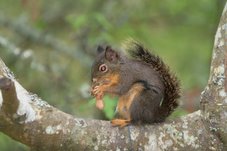
2 comments:
Cathrine...what a wonderful diversion! I sure hope you have sent this to Margot.
Personally, I think that when my scrubs are rotating the peanuts and being so picky that they are trying to tell if there are multiple nuts inside! I am reminded to go out and buy some peanuts the next time I venture out.
Post a Comment